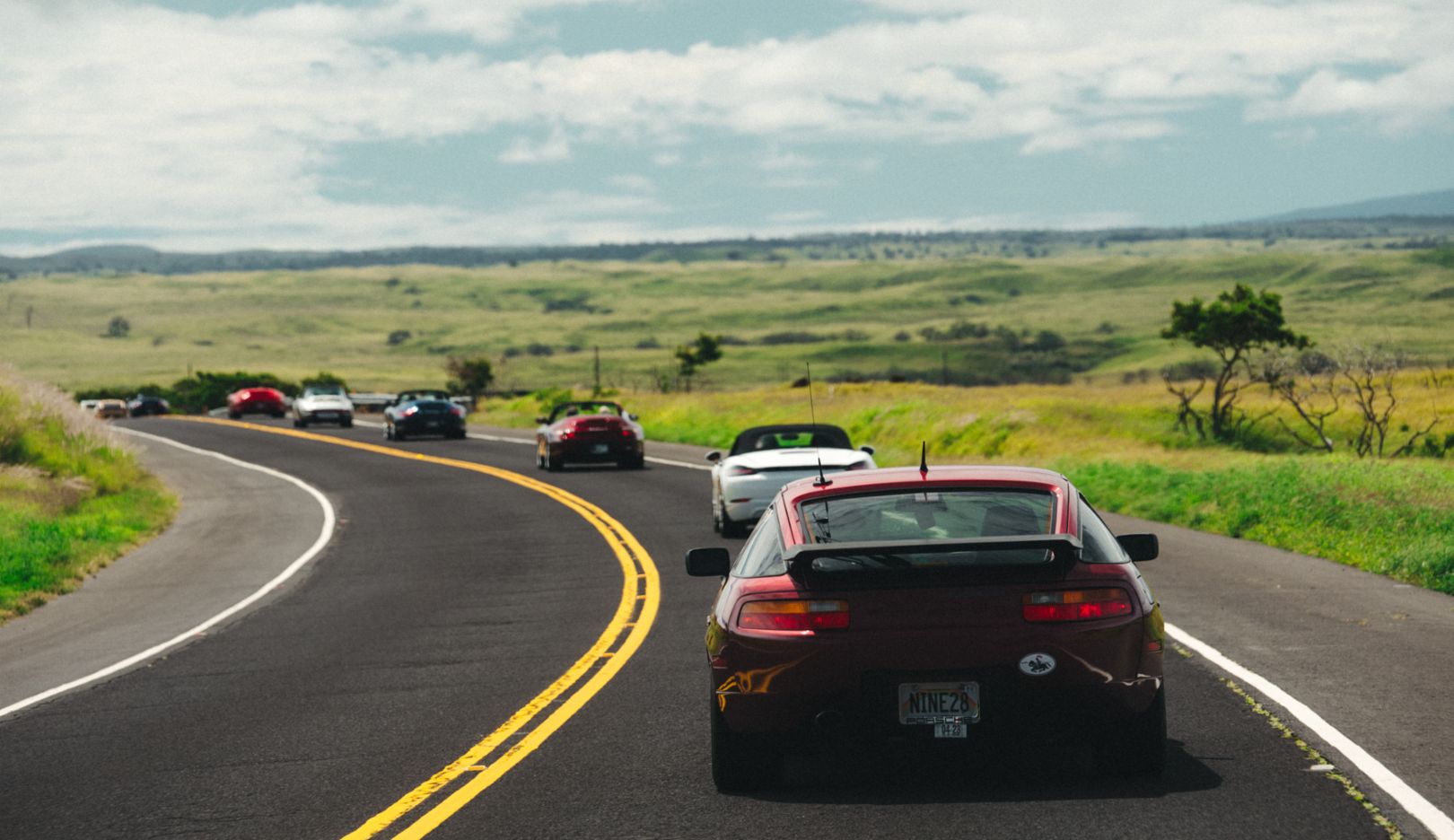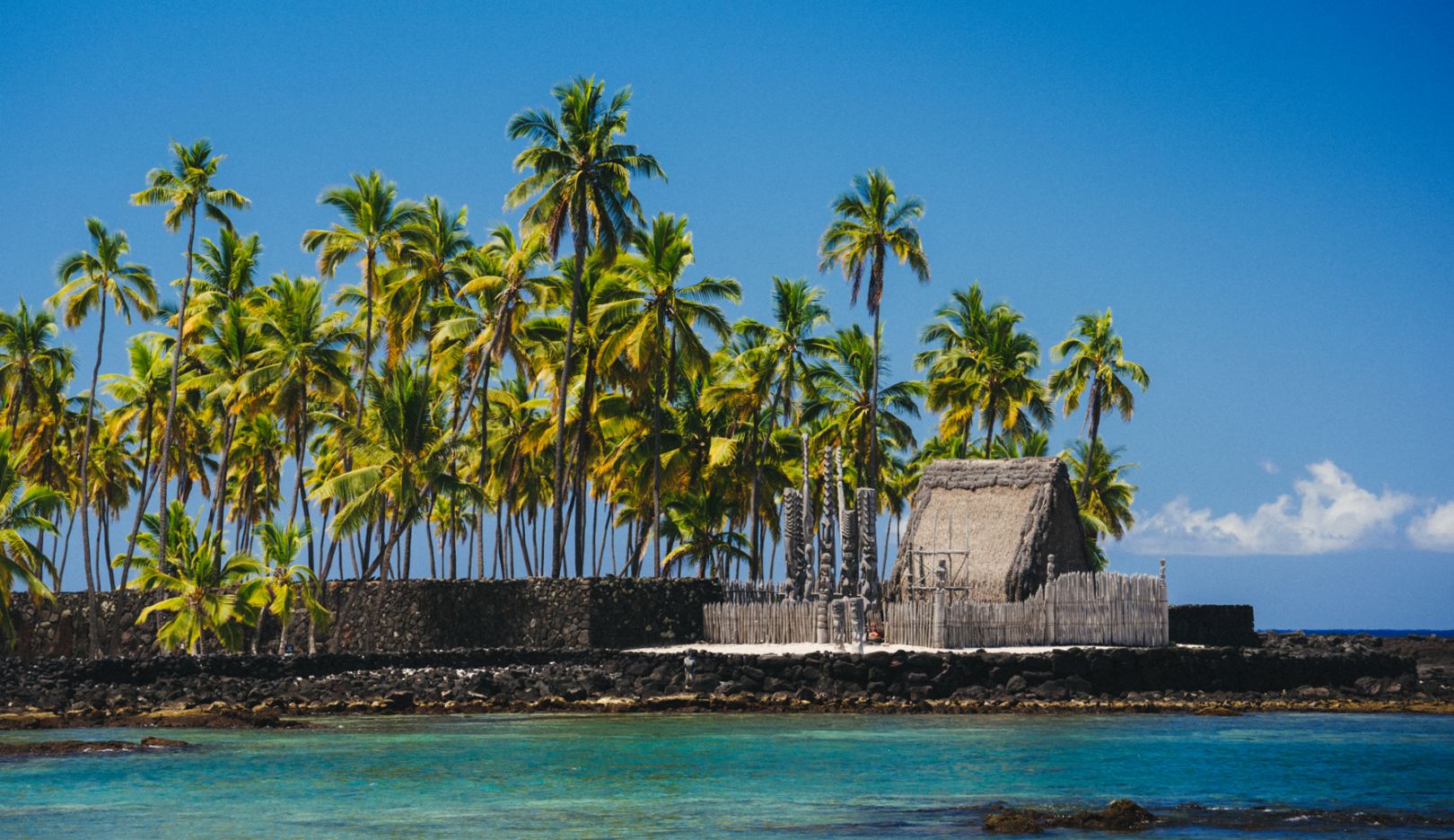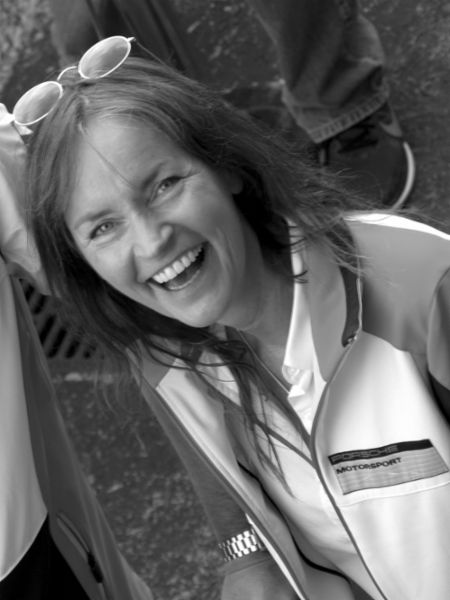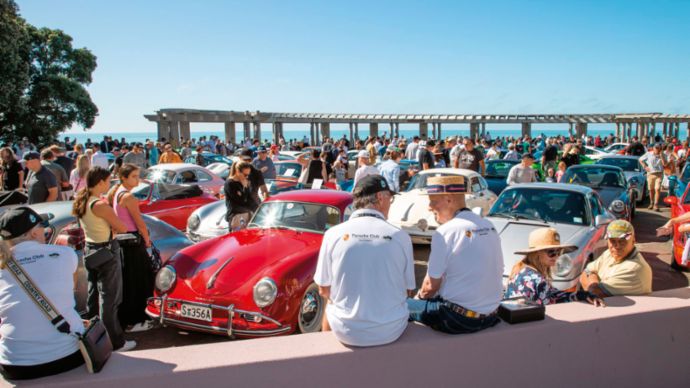The Pearl Necklace
“Aloha!” This Hawaiian greeting expresses compassion, sympathy, and affection, which all combine to form the multifaceted Hawaiian sensibility that also shapes the Porsche Club on the Big Island. One of the people who embodies this spirit in an extraordinary way is the President himself, Gunner Mench.

The President:
Gunner Mench has many talents and now owns an art gallery on the coast."For the Pacific, we’re nothing more than a speed bump,” says Gunner Mench, gazing out at the endless expanse of surging ocean. “If it wanted to, it could overrun us.” From flooding, tsunamis, and volcanic eruptions to fire and even earthquakes, you can expect it all in Hawaii. Like in summer 2023, when devastating bush fires destroyed entire towns. Having lived for three decades on the Big Island, which is by far the largest island of the 50th US state, Gunner Mench is all too familiar with the forces of nature on this pearl necklace island.
The 70-year-old loves the Porsche brand with the same intensity as he does his home. He inherited both passions from his father and, in 2018, married the two when he established the Porsche Club on the Big Island. The exact name: Big Island Hawaii Region of the Porsche Club of America (PCA). As the 144th chapter of the PCA – the largest Porsche Club in the world – the community on the youngest plot of land in the Hawaiian islands already has 170 members five years later.

The embodiment of contrasts:
The Mauna Kea Observatory on the 4,205-meter volcano peak and the beach of Pu’uhonua o Hōnaunau National Historical Park on the western coast of the Big Island (below) are less than two and a half hours apart by car. The 73-hectare park is an impressive expression of Polynesian culture. If the cloud cover is merciful, Mauna Kea offers a view of Mauna Loa (above), which at 4,169 meters is no less formidable.
“The Big Island is a miniature continent. We have just about every climate in the world here. We even have more climates than Australia!” Gunner Mench

Tour of discovery:
On the road with the members and vehicles of the Big Island Porsche Club.Time for the monthly club tour. Like a colorful pearl necklace, the sports cars wind their way along the narrow Waiki’i Ranch Road, which navigates the changing landscape as if squeezed from a tube. The Parker Ranch pastures dominate the land here in the north, interrupted by the occasional colorful western-style town. Mench, the Club President, is at the head of the caravan in his 17-year-old Cayenne S, dubbed the “mountain goat,” which has 350,000 kilometers on the odometer and is loaded with plenty of water and snacks for the drive. Vice President Dr. Mark Senft is bringing up the rear in the 928. And between them there’s a merry band of drivers, including system engineer Michelle Fleischer from Chicago in her 911 Carrera S Cabriolet (991), who got stuck on the Big Island in a lockdown during the coronavirus pandemic. Now she doesn’t want to leave the island and works from home. Bill Hughes came from California with his golden 928 in 2004. “I’ve had the 1980 V8 for 27 years,” he says proudly. Jeff Tanabe, who was born in Hawaii, had to sell his 356 Coupé, but was able to get it back for several times the price decades later. Board member Rémy Striebig brought his love of Porsche from his home in France, where he competed in the 24 Hours of Le Mans in 2016.
He and his wife Shawna now operate an organic farm that grows macadamia nuts and fruit on the northern tip of the island. Everyone has their own stories to tell – stories about Porsche and life on the island.
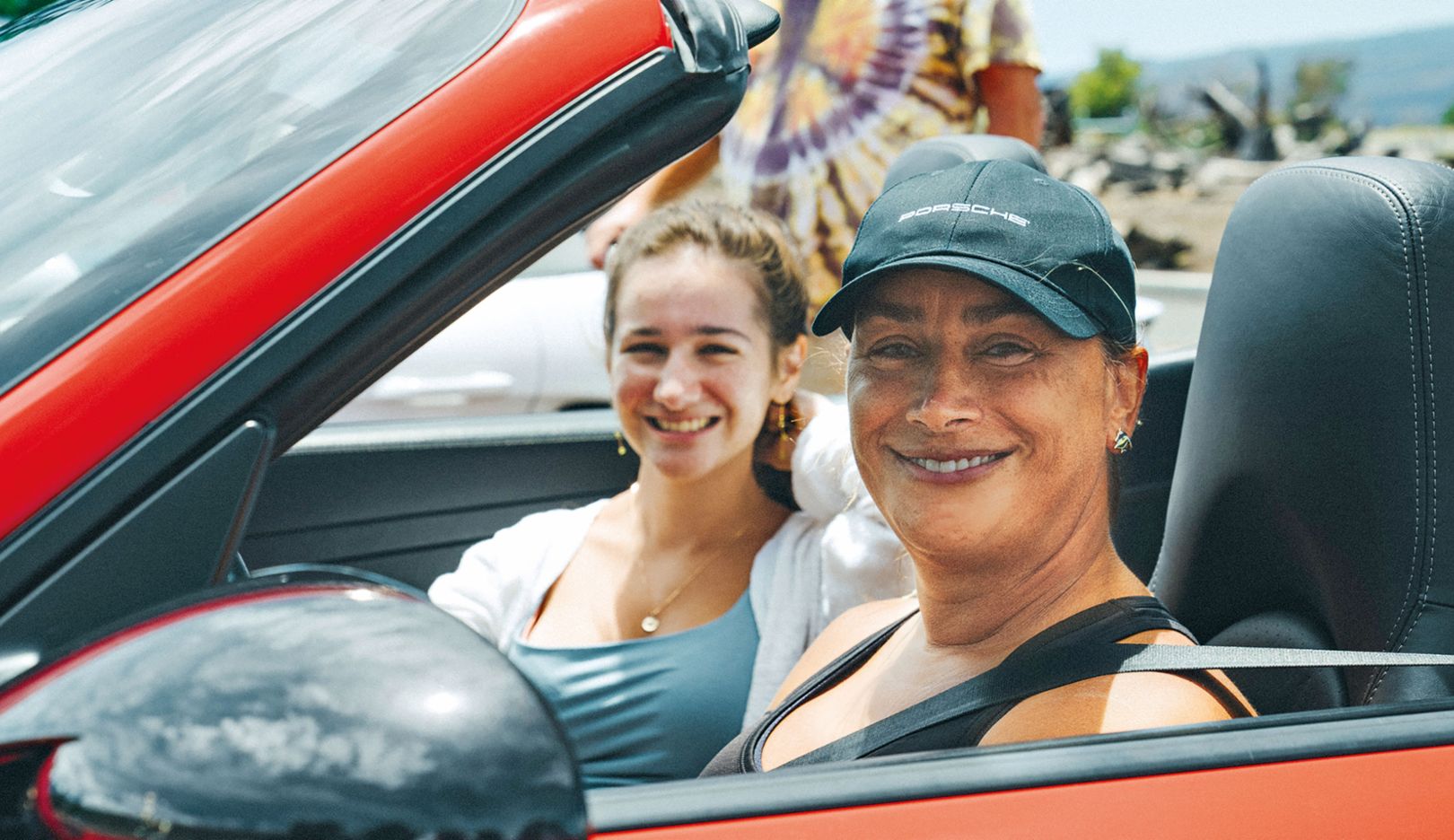
Michelle Fleischer:
She brought her 911 Carrera S Cabriolet when she left Chicago. What she misses in Hawaii? Just her daughter, Celine (left), when she’s not on semester break.Measuring in at around 10,430 square kilometers, the Big Island is larger than all the other Hawaiian islands combined. The first Polynesian settlers landed here around the year 750 and christened the island Hawai’i, which means home in their language. Kamehameha I, who is still honored to this day, embarked on a journey in 1789 to bring the islands together and form his kingdom. Two giant mountains – Mauna Kea and Mauna Loa – tower high above the island. Mauna Kea measures 10,203 meters in height from its base underwater, making it the world’s tallest mountain, and rises 4,205 meters above sea level. At 4,169 meters tall, its neighbor Mauna Loa is only slightly smaller.
We eventually reach the parking lot for Mauna Kea State Park, located between these two superlatives. Pele, the legendary volcano goddess, reveals her softer side, providing a view of the snow-capped peak. While Hawaii doesn’t necessarily conjure images of thick fog and heavy rainfall, they are common on the island. Hilo, the island capital to the east, is the rainiest city in the US, and waterfalls offer diversion in the jungle further to the north along the same coast.

Contrasts:
The Akaka Falls on the northern east coast are surrounded by tropical rainforest (above). Just around 70 kilometers further to the south, desert-like lava fields dominate the barren landscape in Volcanoes National Park (below).
Completely different scenery can be found in Volcanoes National Park in the south, with trails winding through desert-like lava fields that seem to go on forever. Sulfur and water vapors rising among mile-wide craters reveal dangerous, hidden underground pockets of heat. Beaches come in different colors here, including black, the dazzling white of Hapuna and Kaunaoa Beach in the dry northwest, and even green at the southern cape. “The Big Island is a miniature continent,” says Mench. “We have just about every climate in the world here. We even have more climates than Australia!” The only two missing are the extremes: glaciers and desert.
Isolated by thousands of kilometers of ocean, the people here were self-sufficient for centuries, nourished by the sea, fertile soil, and a deep spirituality that you can still feel to this day – for instance, in the ritual Hawaiian hula dance, which is a dialogue with the old gods, and at holy sites for communicating with ancestors, in temples, and in houses of prayer for different religions.

Porsche pearl necklace:
Members of the Big Island Porsche Club get together for a drive once a month. Mench takes us to his favorite spots on the island before and after the tour, selecting the 911 SC Targa, built in 1980 (below), for the visit to the Aloha Theatre.
The many Christian churches are the legacy of the missionaries who came from North America around 1820 and taught the population to read and write. “We live in a melting pot of different cultures, ethnicities, and languages,” explains Mench. During a stop in Church Row in his town of Waimea, which is also known as Kamuela, he suddenly breaks out in song – the Apostles’ Creed melodically sung in Hawaiian. “That’s how we sing it in our congregation. Yeah, I used to make music.” He goes on to talk about his greatest performance at a folk festival in 1972 – just him and his guitar in front of an audience of 4,000. “I have many lives,” he says smiling. He invites us into his home to continue the conversation. The wooden house is shaped by 40 years of weather and features the typical veranda, with bananas, avocados, pineapples, oranges, and guavas growing in the yard. Wild chickens run loose all over Hawaii and provide a fresh supply of eggs daily.
Self-sufficiency is the name of the game, as life on the island is expensive. Two ponies are responsible for maintaining the front yard and graze around a 914 chassis that just might be beyond saving. The lifted 944 Turbo behind it is waiting for an engine, while the 944 in Cream White, a birthday present for Mench’s wife Elli, is parked on the edge of the road, ready to drive. The Cayenne behind that, a first generation from 2005, is currently indisposed. “Our house is a good 90 square meters in size, which is plenty of space for us,” says Mench. “But the garage is 10 square meters bigger and still too small.”

Hawaiian collection:
Measuring 100 square meters in space, Mench’s garage is too small for his sports cars. Parked in the middle is a rare 911 Turbo Cabriolet (G-Series), with which we visit Kawaihae on the west coast in the evening.His 356 B 1600 Super, built in 1963, is parked in front of a covered 928 S4 to the left. “I drove it up to the peak of Mauna Kea four times,” says Mench. “Unfortunately, you can only take an all-wheel drive up to the observatories today.” We fully understand these rules, as the gravel road, which starts at an elevation of 3,000 meters, can be challenging even for a modern SUV. The visitor center is located at that level, where breathing is noticeably more difficult and rangers make sure you stop for at least half an hour to acclimate before tackling the final 1,200 meters of elevation. They also check the temperature of your brakes on the way down. People tend to be friendly, empathetic, and patient during encounters like these, which is typical of the Aloha State.
There are four 911 cars in a section of the garage to the right. “There’s only one 911 SC Targa from 1980 in this green,” says our host. “That was the color ordered by the first owner, a businessman in Miami.” There’s a 911 Coupé (G-Series, built in 1974) on the lifting platform, and next to it a 912 E that’s two years younger and one of 2,099 vehicles with a 914 engine, which were built for the US market. Then there’s a red 911 Turbo Cabriolet from 1989 – one of 540 in the US design. “But the only thing you can possess in life is experiences,” emphasizes Mench. He grabs a frame from the wall containing a faded greeting card addressed to him and his brother. “Günther and Charlie – greetings, Uncle Ferry Porsche.” A small postcard that tells a big story.
Born Günther Franz Mench in Würzburg, Germany, in 1954, Gunner immigrated with his family to Ridgefield in the US state of Connecticut in 1955. In Germany, his father Georg Mench was an institution in the world of journalism and photography. He knew Ferdinand and Ferry Porsche well, documented the grand opening of the Zuffenhausen factory at the beginning of the 1950s, and developed an early marketing tool: postcards showcasing vehicles.

Fading greeting cards:
The Mench family maintained contact with many historical figures, including Haile Selassie, then Emperor of Ethiopia (above); US astronaut John H. Glenn (middle); and Ferry Porsche.“Every image tells a story and provides a glimpse of a desirable lifestyle,” says Mench enthusiastically, browsing through the 72 cards. “My father was allowed to use the Porsche logo and sold the cards to dealerships. The dealers then gave them to their customers, who in turn sent them all over the world.” One of the images ended up on the cover of Christophorus in 1961.

Artistic cover story:
The Christophorus editorial team used a photo taken by Gunner Mench’s father on the cover in 1961 – issue 53 in the German publication and the 36th magazine in English.
Unity:
When Mench travels to the mainland, it’s usually to get together with the Porsche community for events like the Rennsport Reunion.Mench senior maintained quite an impressive network. And in Connecticut, Gunner learned to live life at his father’s speed, flying from one state to the next as a businessman in top management. “300,000 miles of short-haul flights in six years. Board, buckle up, fall asleep,” he says, recalling his days in a suit and tie.
In 1990, when he was 36 years old, he visited his father, who was already living on the Big Island and was getting married for the second time. “Country life there reminded me of my childhood in New England,” says Mench. “But there were also beaches and everything else I was looking for.” He decided to stay and completed an auto mechanic vocational course, earning a certificate from the National Institute for Automotive Service Excellence (ASE), became the manager of an Italian restaurant, and ultimately found joy while working at an art gallery, which he took over in 2004. At Harbor Gallery in Waimea – just 25 kilometers, but multiple climates, from his house in the mountains, he and his wife promote around 150 regional artists.
The business is open every day of the year, except for Christmas Eve. Or during a lockdown. When the pandemic brought the world to a standstill, Mench advertised his gallery on the radio. And when Mauna Loa erupted again for the first time in nearly 40 years on November 27, 2022, he jumped in his Cayenne, published the first photographs online, and was promptly promoted to popular interview partner.
What Mench loves about Porsche led to the foundation of the Big Island Club and its motto, “It’s not just the cars, it’s the people.” Exchange and camaraderie are of vital importance on a relatively defenseless speed bump in the middle of the Pacific. That’s something that we, too, had the opportunity to experience during the monthly club meeting. “Aloha” embodies this spirit and is how the club members say goodbye to each other today.



